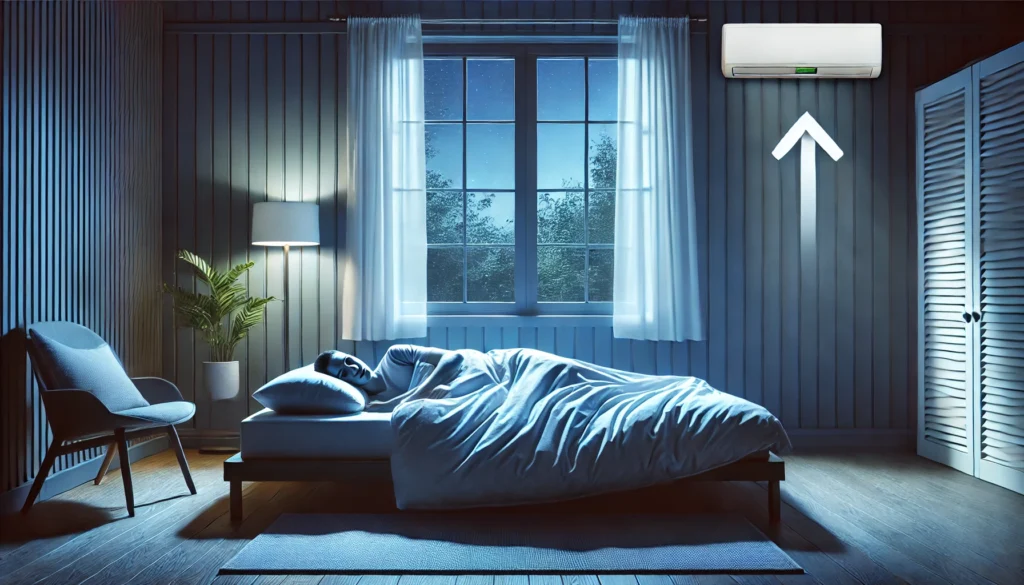To grasp why your body heats up while sleeping, it’s essential to understand how the body regulates temperature. The hypothalamus, a small region in the brain, acts as the body’s thermostat. It maintains a balance between heat production and heat loss, ensuring the body stays within a narrow temperature range, typically around 37°C (98.6°F).
The Role of the Hypothalamus
The hypothalamus is a critical player in the body’s temperature regulation system. It constantly receives input from temperature receptors in the skin and internal organs, adjusting processes like sweating, shivering, and blood flow to maintain an optimal temperature. By understanding these mechanisms, we can appreciate the hypothalamus’s role in keeping us comfortable both day and night.
Circadian Rhythm and Temperature
The circadian rhythm is an internal clock that influences various physiological processes, including body temperature. This rhythm causes fluctuations in temperature that align with daily cycles of light and darkness. During the day, exposure to light signals the hypothalamus to keep body temperature relatively high, while darkness triggers cooling, preparing the body for rest.
The Sleep-Wake Cycle
The sleep-wake cycle is closely tied to temperature regulation. As evening approaches, the body begins to cool down, reaching its lowest temperature in the early morning hours. This cooling process is a signal for the body to wind down and enter sleep. During the night, as sleep progresses, temperature rises slightly, corresponding with changes in sleep stages and hormonal activity.
You May Also Like: Benefits of Consistent Sleep Schedules Explained
Why Does Your Body Temperature Fluctuate at Night?
During the day, your body temperature follows a circadian rhythm, peaking in the late afternoon and dropping to its lowest point during the early morning hours. This drop in temperature signals to your body that it’s time to sleep. However, once you fall asleep, your body temperature begins to rise again slightly. This fluctuation is part of the body’s natural sleep-wake cycle and is influenced by various factors, including hormone levels, metabolic rate, and sleep stages.
Hormonal Influences on Temperature
Hormones have a significant influence on nighttime temperature changes. Melatonin, known as the “sleep hormone,” is produced by the pineal gland in response to darkness and aids in lowering body temperature. This drop helps facilitate the onset of sleep. Meanwhile, cortisol, often called the “stress hormone,” starts to increase in the early morning, encouraging a rise in body temperature as the body prepares to wake up.
Metabolic Changes During Sleep
Metabolic rate fluctuations also contribute to temperature changes during sleep. As you transition through different sleep stages, your body’s energy consumption and heat production vary. For example, during REM sleep, the body becomes less efficient at temperature regulation, leading to slight increases in core temperature. These changes are essential for maintaining the body’s natural sleep architecture.
Sleep Stages and Temperature Variations
Each sleep stage has distinct characteristics and affects body temperature differently. Non-REM sleep, particularly the deeper stages, is associated with lower metabolic rates and cooler body temperatures. In contrast, REM sleep is linked to increased brain activity and higher energy expenditure, which can result in a slight temperature rise. Understanding these variations can help in creating a conducive sleep environment.

Factors Contributing to Increased Body Temperature During Sleep
Several factors can contribute to an increase in body temperature while sleeping. Understanding these can help you manage and optimize your sleep environment.
Bedding and Sleepwear
The materials used in bedding and sleepwear can significantly impact how warm or cool you feel at night. Natural fibers like cotton and bamboo are breathable and help regulate temperature, while synthetic materials can trap heat and increase body temperature.
Choosing the Right Fabrics
Choosing breathable fabrics is crucial for temperature regulation during sleep. Cotton and bamboo are excellent choices as they allow for airflow and wick moisture away from the body. In contrast, synthetic fabrics like polyester may trap heat and prevent proper ventilation, leading to discomfort and overheating.
The Impact of Bedding Layers
Layering your bedding can also affect your nighttime temperature. Using multiple lightweight layers allows you to adjust your comfort level easily. Consider using a breathable mattress topper and duvet, which can help regulate body temperature by providing insulation while allowing moisture to escape.
Sleepwear Styles and Comfort
The style and fit of your sleepwear can influence your sleep temperature. Loose-fitting pajamas made from breathable materials can enhance air circulation, while tight or heavy clothing may restrict airflow and cause overheating. Opting for sleeveless or short-sleeved options can further aid in temperature regulation.
Room Temperature and Humidity
The ambient temperature and humidity of your sleeping environment also play crucial roles. Ideally, your bedroom should be kept cool, between 60-67°F (15-19°C), to facilitate optimal sleep. High humidity levels can prevent sweat evaporation, making you feel warmer.
Setting the Ideal Room Temperature
Maintaining a cool room temperature is vital for promoting restful sleep. Using fans or air conditioning can help achieve the ideal range of 60-67°F (15-19°C). A programmable thermostat can also be helpful, allowing you to set different temperatures for day and night to ensure a consistent sleep environment.
Managing Humidity Levels
Humidity levels can significantly impact how we perceive temperature. High humidity can make the air feel warmer, as it hinders sweat evaporation. To manage humidity, consider using a dehumidifier in your bedroom or keeping windows open to promote airflow and moisture control.
The Role of Ventilation
Proper ventilation is essential for maintaining a comfortable sleep environment. Ensuring that your bedroom is well-ventilated can help prevent the buildup of heat and humidity. Regularly opening windows or using fans to circulate air can enhance comfort and contribute to a better night’s sleep.
Sleep Stages and Metabolic Rate
Your body’s metabolic rate varies throughout the night, depending on the sleep stage. During REM (Rapid Eye Movement) sleep, the body’s ability to regulate temperature is reduced, leading to potential increases in body heat. Additionally, a higher metabolic rate can generate more heat.
Understanding Non-REM Sleep
Non-REM sleep consists of three stages, each with distinct characteristics. During these stages, the body conserves energy, and the temperature naturally drops. This reduction in body temperature is crucial for cell repair and growth, allowing the body to rejuvenate and prepare for the demands of the day.
The Dynamics of REM Sleep
REM sleep is a paradoxical state where the brain is highly active, yet the body remains mostly still. During this stage, the body’s temperature regulation mechanisms are less effective, which can lead to increased body heat. This phase is essential for cognitive function and emotional processing, highlighting the balance between sleep stages and temperature.
Metabolic Rate and Heat Production
The body’s metabolic rate is not constant during sleep. It varies based on the current sleep stage and individual factors such as age and activity level. Understanding these variations can help tailor your sleep environment and habits to minimize disruptions caused by temperature fluctuations.

The Implications of Elevated Body Temperature on Sleep
An elevated body temperature during sleep can have several implications, affecting both sleep quality and overall health.
Impact on Sleep Quality
Hot body temperature during sleep can lead to discomfort, frequent awakenings, and reduced sleep quality. It can also disrupt the natural progression through sleep stages, particularly affecting REM sleep, which is crucial for cognitive function and emotional regulation.
Discomfort and Sleep Disruptions
When body temperature is too high, it can cause physical discomfort, leading to tossing and turning. This restlessness can interrupt the sleep cycle, causing frequent awakenings and preventing you from reaching the deeper, restorative stages of sleep necessary for feeling refreshed in the morning.
Interruptions in REM Sleep
REM sleep, the stage associated with vivid dreams and essential cognitive functions, is particularly sensitive to temperature changes. Elevated body temperature can shorten the duration of REM sleep, impacting memory consolidation and emotional stability, and leaving you feeling groggy and unfocused.
Long-Term Effects on Sleep Patterns
Chronic disruptions in sleep due to temperature can lead to long-term changes in sleep patterns. Over time, this can result in sleep deficits and increased sleep pressure, where the body demands more rest to compensate for lost sleep, potentially leading to insomnia or other sleep disorders.
Health and Wellness Consequences
Chronic sleep disruption due to elevated body temperature can have long-term health consequences, including increased risk of metabolic disorders, impaired immune function, and mood disturbances. It is essential to address and manage factors contributing to sleep-related temperature increases.
Metabolic Health Risks
Persistent sleep disturbances from elevated temperature can contribute to metabolic issues like obesity and diabetes. Insufficient sleep affects the hormones that regulate appetite and glucose metabolism, increasing the risk of weight gain and insulin resistance.
Immune System Implications
Quality sleep is vital for a robust immune system. Chronic sleep deprivation due to heat can weaken immune response, making you more susceptible to infections and illnesses. Ensuring a cool sleeping environment can aid in maintaining immune health and overall well-being.
Emotional and Mental Health
Sleep is closely linked to mood regulation and mental health. Consistently poor sleep due to high temperature can lead to mood swings, irritability, and even anxiety or depression. Addressing sleep temperature issues can improve mental resilience and emotional stability.
Practical Tips for Managing Body Temperature During Sleep
Implementing strategies to regulate body temperature can improve sleep quality and enhance overall health.
Optimize Your Sleep Environment
- Adjust Room Temperature: Use a fan or air conditioning to maintain a cool bedroom environment.
- Choose Breathable Bedding: Opt for natural fiber sheets and lightweight blankets.
- Wear Lightweight Sleepwear: Choose breathable, loose-fitting clothing to prevent overheating.
Using Fans and Air Conditioning
Fans and air conditioning are effective tools for regulating room temperature. Strategically placing fans can enhance airflow, while air conditioning can maintain a stable and cool environment, promoting deeper, more restful sleep.
Selecting Temperature-Controlled Bedding
Investing in temperature-controlled bedding, such as cooling mattresses or pillows, can help manage body heat during the night. These products are designed to dissipate heat and moisture, providing a comfortable sleep surface.
Evaluating and Adjusting Sleepwear
Choose sleepwear that is appropriate for the season and personal comfort. Lightweight, breathable fabrics are ideal for warmer nights, while layering can provide warmth without causing overheating during cooler seasons.
Establish a Relaxing Bedtime Routine
- Take a Warm Bath: A warm bath before bed can promote sleep by initially raising and then lowering body temperature, signaling to your body that it’s time to sleep.
- Practice Relaxation Techniques: Deep breathing, meditation, or gentle yoga can help reduce stress and lower body temperature.
The Benefits of a Warm Bath
A warm bath can be a soothing pre-sleep ritual that helps regulate body temperature. The initial rise in body heat followed by a gradual cooling can signal the body that it’s time to sleep, helping transition into a restful state more easily.
Incorporating Relaxation Practices
Incorporating relaxation techniques into your bedtime routine can aid in stress reduction and temperature regulation. Practices like meditation or gentle yoga promote relaxation, lowering cortisol levels and helping the body cool down in preparation for sleep.
The Importance of Consistency
Establishing a consistent bedtime routine can reinforce the body’s natural sleep-wake cycle. By consistently practicing relaxation techniques and maintaining a regular sleep schedule, you can enhance your body’s ability to regulate temperature effectively.
Monitor and Adjust Your Lifestyle
- Stay Hydrated: Dehydration can affect your body’s ability to regulate temperature, so drink plenty of water throughout the day.
- Limit Caffeine and Alcohol: Both can interfere with your body’s natural temperature regulation, particularly if consumed close to bedtime.
Importance of Hydration
Staying adequately hydrated supports the body’s natural cooling processes. Water helps regulate body temperature by facilitating sweat production and circulation. Drinking water throughout the day ensures your body is prepared to manage heat effectively.
Moderating Caffeine and Alcohol Intake
Caffeine and alcohol can disrupt sleep and interfere with body temperature regulation. Limiting these substances, particularly in the evening, can help maintain optimal sleep conditions and prevent temperature-related disruptions.
Adopting a Balanced Lifestyle
Overall lifestyle choices, including diet, exercise, and stress management, can influence sleep temperature. A balanced diet rich in nutrients, regular physical activity, and effective stress management techniques can support better temperature regulation and improved sleep quality.

Conclusion
Understanding and managing body temperature during sleep is a key component of optimizing sleep quality and overall health. By being mindful of your sleep environment and daily habits, you can create a restful, rejuvenating nighttime experience. As research continues to uncover the intricacies of sleep and temperature regulation, staying informed will empower you to make the best choices for your health and wellness. Embrace these insights to enjoy cooler, more restful nights and wake up feeling refreshed and revitalized.
Further Reading:
How to Beat the Heat for a Restful Sleep
Effects of thermal environment on sleep and circadian rhythm
Why Do I Get So Hot When I Sleep? + 23 Tips for Hot Sleepers To Cool Down
Important Note: The information contained in this article is for general informational purposes only, and should not be construed as health or medical advice, nor is it intended to diagnose, prevent, treat, or cure any disease or health condition. Before embarking on any diet, fitness regimen, or program of nutritional supplementation, it is advisable to consult your healthcare professional in order to determine its safety and probable efficacy in terms of your individual state of health.
Regarding Nutritional Supplements Or Other Non-Prescription Health Products: If any nutritional supplements or other non-prescription health products are mentioned in the foregoing article, any claims or statements made about them have not been evaluated by the U.S. Food and Drug Administration, and such nutritional supplements or other health products are not intended to diagnose, treat, cure, or prevent any disease.


